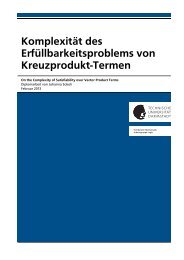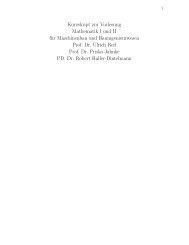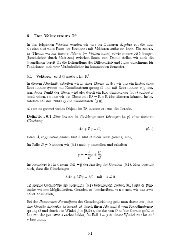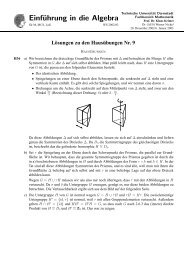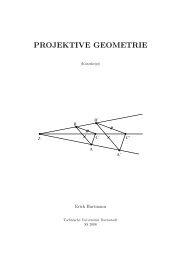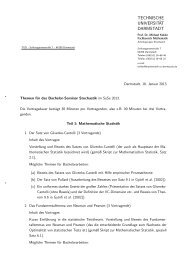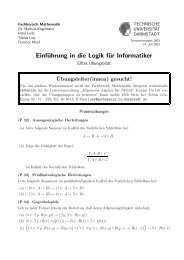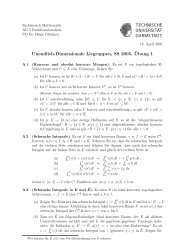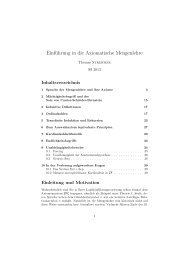Upper bounds for Bermudan options on Markovian data using ...
Upper bounds for Bermudan options on Markovian data using ...
Upper bounds for Bermudan options on Markovian data using ...
Create successful ePaper yourself
Turn your PDF publications into a flip-book with our unique Google optimized e-Paper software.
<str<strong>on</strong>g>Upper</str<strong>on</strong>g> <str<strong>on</strong>g>bounds</str<strong>on</strong>g> <str<strong>on</strong>g>for</str<strong>on</strong>g> <str<strong>on</strong>g>Bermudan</str<strong>on</strong>g> <str<strong>on</strong>g>opti<strong>on</strong>s</str<strong>on</strong>g> <strong>on</strong> <strong>Markovian</strong> <strong>data</strong><br />
<strong>using</strong> n<strong>on</strong>parametric regressi<strong>on</strong> and a reduced number of<br />
nested M<strong>on</strong>te Carlo steps<br />
Michael Kohler,Adam Krzy˙zak,Harro Walk<br />
Summary: This paper is c<strong>on</strong>cerned with evaluati<strong>on</strong> of American <str<strong>on</strong>g>opti<strong>on</strong>s</str<strong>on</strong>g> also called <str<strong>on</strong>g>Bermudan</str<strong>on</strong>g> <str<strong>on</strong>g>opti<strong>on</strong>s</str<strong>on</strong>g> in discrete<br />
time. We use the dual approach to derive upper <str<strong>on</strong>g>bounds</str<strong>on</strong>g> <strong>on</strong> the price of such <str<strong>on</strong>g>opti<strong>on</strong>s</str<strong>on</strong>g> <strong>using</strong> <strong>on</strong>ly a reduced number of<br />
nested M<strong>on</strong>te Carlo steps. The key idea is to apply n<strong>on</strong>parametric regressi<strong>on</strong> to estimate c<strong>on</strong>tinuati<strong>on</strong> values and all<br />
other required c<strong>on</strong>diti<strong>on</strong>al expectati<strong>on</strong>s and to combine the resulting estimate with another estimate computed by <strong>using</strong><br />
<strong>on</strong>ly a reduced number of nested M<strong>on</strong>te Carlo steps. The expectati<strong>on</strong> of the resulting estimate is an upper bound <strong>on</strong> the<br />
opti<strong>on</strong> price. It is shown that the estimates of the opti<strong>on</strong> prices are universally c<strong>on</strong>sistent, i.e., they c<strong>on</strong>verge to the true<br />
price regardless of the structure of the c<strong>on</strong>tinuati<strong>on</strong> values. The finite sample behavior is validated by experiments <strong>on</strong><br />
simulated <strong>data</strong>.<br />
1 Introducti<strong>on</strong><br />
The main advantage of M<strong>on</strong>te Carlo methods <str<strong>on</strong>g>for</str<strong>on</strong>g> pricing American <str<strong>on</strong>g>opti<strong>on</strong>s</str<strong>on</strong>g> in discrete time, also called<br />
<str<strong>on</strong>g>Bermudan</str<strong>on</strong>g> <str<strong>on</strong>g>opti<strong>on</strong>s</str<strong>on</strong>g>, is that they can be computed quickly compared to other methods when the number of<br />
underlying assets or state variables is large. One way to apply them is to use the dual representati<strong>on</strong> of the<br />
price V0 of an American opti<strong>on</strong> in discrete time given by<br />
V0 = inf<br />
M∈M E<br />
<br />
max<br />
t=0,...,T (ft(Xt)<br />
<br />
− Mt) . (1.1)<br />
Here X0, X1, . . . , XT denote the underlying <strong>Markovian</strong> process describing, e.g., the prices of the under-<br />
lyings and the financial envir<strong>on</strong>ment (like interest rates, etc.), ft is the discounted payoff functi<strong>on</strong> and M<br />
is the set of all martingales M0, . . . , MT with M0 = 0 (cf. Rogers (2001), Haugh and Kogan (2004), or<br />
AMS 1991 subject classificati<strong>on</strong>: Primary 91B28, 60G40, 62G08; sec<strong>on</strong>dary 65C05, 93E24<br />
Key words and phrases: American <str<strong>on</strong>g>opti<strong>on</strong>s</str<strong>on</strong>g>, c<strong>on</strong>sistency, dual method, n<strong>on</strong>parametric regressi<strong>on</strong>, regressi<strong>on</strong>-based M<strong>on</strong>te Carlo meth-<br />
ods
2 Kohler – Krzy˙zak – Walk<br />
Secti<strong>on</strong> 8.7 in Glasserman (2004)). Neither the Markov property nor the <str<strong>on</strong>g>for</str<strong>on</strong>g>m of the payoff as a functi<strong>on</strong> of<br />
the state Xt is restrictive and can always be achieved by including supplementary variables.<br />
We next describe the optimal martingale M ∗ t<br />
at which the infimum in (1.1) is reached. Let T (t +<br />
1, . . .,T) be the class of all {t+1, . . ., T }–valued stopping times, i.e., of all functi<strong>on</strong>s τ = τ(X0, . . .,XT)<br />
with values in {t + 1, . . .,T } satisfying<br />
Let<br />
{τ = α} ∈ F(X0, . . . , Xα) <str<strong>on</strong>g>for</str<strong>on</strong>g> all α ∈ {t + 1, . . .,T }.<br />
qt(x) = sup<br />
τ ∈T (t+1,...,T)<br />
E {fτ(Xτ)|Xt = x}<br />
(t ∈ {0, . . ., T − 1}) be the so–called c<strong>on</strong>tinuati<strong>on</strong> values describing the value of the opti<strong>on</strong> at time t given<br />
Xt = x and subject to the c<strong>on</strong>straint of holding the opti<strong>on</strong> at time t rather than exercising it. It can be<br />
shown that the optimal martingale M ∗ t is given by<br />
M ∗ t =<br />
t<br />
(max{fs(Xs), qs(Xs)} − qs−1(Xs−1)) (t ∈ {1, . . ., T }) (1.2)<br />
s=1<br />
(cf., e.g., Secti<strong>on</strong> 8.7 in Glasserman (2004)). Because of<br />
(cf. Tsitsiklis and van Roy (1999)) M ∗ t<br />
qs−1(Xs−1) = E {max{fs(Xs), qs(Xs)}|Xs−1} (1.3)<br />
is indeed a martingale.<br />
Using (1.3) (or other regressi<strong>on</strong> representati<strong>on</strong>s like the <strong>on</strong>es in L<strong>on</strong>gstaff and Schwartz (2001) or Egloff<br />
(2005)) the c<strong>on</strong>tinuati<strong>on</strong> values can be estimated recursively by the M<strong>on</strong>te Carlo method. This approach has<br />
been proposed <str<strong>on</strong>g>for</str<strong>on</strong>g> linear regressi<strong>on</strong> in Tsitsiklis and van Roy (1999) and L<strong>on</strong>gstaff and Schwartz (2001).<br />
Egloff (2005), Egloff, Kohler and Todorovic (2007), Kohler, Krzy˙zak and Todorovic (2006), and Kohler<br />
(2008a) introduced various estimates based <strong>on</strong> n<strong>on</strong>parametric regressi<strong>on</strong>.<br />
With such estimates ˆqs of qs the optimal martingale M ∗ t<br />
ˆMt =<br />
t<br />
s=1<br />
can be estimated by<br />
<br />
max{fs(Xs), ˆqs(Xs)} − Ê {max{fs(Xs),<br />
<br />
ˆqs(Xs)}|Xs−1}<br />
(t ∈ {1, . . .,T }) (1.4)<br />
and ˆ M0 = 0. As l<strong>on</strong>g as Ê is an unbiased estimate of the corresp<strong>on</strong>ding c<strong>on</strong>diti<strong>on</strong>al expectati<strong>on</strong>, ˆ Mt will<br />
be a martingale and according to (1.1)<br />
<br />
E<br />
max<br />
t=0,...,T<br />
<br />
ft(Xt) − ˆ <br />
Mt<br />
<br />
will be an upper bound <strong>on</strong> the price of the opti<strong>on</strong>. Similar estimates have been introduced in Rogers (2001)<br />
and Haugh and Kogan (2004), where linear regressi<strong>on</strong> was used to estimate the c<strong>on</strong>tinuati<strong>on</strong> values recur-<br />
sively, and where nested M<strong>on</strong>te Carlo was used to get unbiased estimates Ê of the c<strong>on</strong>diti<strong>on</strong>al expectati<strong>on</strong>
<str<strong>on</strong>g>Upper</str<strong>on</strong>g> <str<strong>on</strong>g>bounds</str<strong>on</strong>g> <str<strong>on</strong>g>for</str<strong>on</strong>g> <str<strong>on</strong>g>Bermudan</str<strong>on</strong>g> <str<strong>on</strong>g>opti<strong>on</strong>s</str<strong>on</strong>g> 3<br />
occuring in (1.2) (cf. (1.3)). Jamshidian (2007) studied multiplicative versi<strong>on</strong>s of this method. A compara-<br />
tive study of multiplicative and additive duals is c<strong>on</strong>tained in Chen and Glasserman (2007). Andersen and<br />
Broadie (2004) derive upper and lower <str<strong>on</strong>g>bounds</str<strong>on</strong>g> <str<strong>on</strong>g>for</str<strong>on</strong>g> American <str<strong>on</strong>g>opti<strong>on</strong>s</str<strong>on</strong>g> based <strong>on</strong> duality.<br />
Kohler (2008b) applied n<strong>on</strong>parametric regressi<strong>on</strong> in this c<strong>on</strong>text. It was shown that the resulting esti-<br />
mates of the opti<strong>on</strong> price c<strong>on</strong>verge to the true values regardless of the structure of the c<strong>on</strong>tinuati<strong>on</strong> values,<br />
and that their per<str<strong>on</strong>g>for</str<strong>on</strong>g>mance <strong>on</strong> simulated <strong>data</strong> was superior to the estimates based <strong>on</strong> linear regressi<strong>on</strong>. How-<br />
ever, the use of nested M<strong>on</strong>te Carlo substantially increased the computati<strong>on</strong>al burden. In a Brownian moti<strong>on</strong><br />
setting Belomestny, Bender and Schoenmakers (2007) proposed dual estimates of opti<strong>on</strong> prices which do<br />
not require nested M<strong>on</strong>te Carlo and hence can be computed significantly faster.<br />
In this article we introduce <str<strong>on</strong>g>for</str<strong>on</strong>g> general <strong>Markovian</strong> processes dual M<strong>on</strong>te Carlo estimates based <strong>on</strong><br />
n<strong>on</strong>parametric regressi<strong>on</strong> which do not require many nested M<strong>on</strong>te Carlo steps. The key idea is to define<br />
dual estimates where all c<strong>on</strong>diti<strong>on</strong>al expectati<strong>on</strong>s are estimated by n<strong>on</strong>parametric regressi<strong>on</strong>. In general<br />
there is no guarantee that the expectati<strong>on</strong> of this kind of estimate is an upper bound <strong>on</strong> the opti<strong>on</strong> price.<br />
However, by combining it with a dual estimate of the opti<strong>on</strong> price based <strong>on</strong> n<strong>on</strong>parametric regressi<strong>on</strong> and<br />
nested M<strong>on</strong>te Carlo we c<strong>on</strong>struct another estimate, which has this property, and which requires <strong>on</strong>ly a<br />
reduced number of nested M<strong>on</strong>te Carlo steps. We show that our new estimates are universally c<strong>on</strong>sistent,<br />
i.e., they c<strong>on</strong>verge to the true price regardless of the structure of the c<strong>on</strong>tinuati<strong>on</strong> values. We illustrate the<br />
finite sample behavior of our estimates by experiments <strong>on</strong> simulated <strong>data</strong>.<br />
The definiti<strong>on</strong> of the estimates is given in Secti<strong>on</strong> 2. Our main theoretical result c<strong>on</strong>cerning c<strong>on</strong>sistency<br />
of the estimates is presented in Secti<strong>on</strong> 3 and proven in Secti<strong>on</strong> 5. Secti<strong>on</strong> 4 c<strong>on</strong>tains an applicati<strong>on</strong> of our<br />
method to simulated <strong>data</strong>.<br />
2 Definiti<strong>on</strong> of the estimate<br />
Let X0, X1, . . .,XT be a IR d –valued Markov process and let ft be the discounted payoff functi<strong>on</strong> which<br />
we assume to be bounded in absolute value by L. We assume that the <strong>data</strong> generating process is completely<br />
known, i.e., that all parameters of this process are already estimated from historical <strong>data</strong>. In this secti<strong>on</strong> we<br />
describe dual M<strong>on</strong>te Carlo methods <str<strong>on</strong>g>for</str<strong>on</strong>g> estimati<strong>on</strong> of V0.<br />
We start with the algorithm from Kohler (2008b) <strong>using</strong> nested M<strong>on</strong>te Carlo and n<strong>on</strong>parametric re-<br />
gressi<strong>on</strong>. The algorithm uses artificially generated independent Markov processes {Xi,t}t=0,...,T (i =<br />
1, 2, . . ., n + Nn) which are identically distributed as {Xt}t=0,...,T . In additi<strong>on</strong> we use random variables<br />
{X (k)<br />
i,t }t=0,...,T (i = n + 1, . . .,n + Nn, k = 1, . . .,Kn) which are c<strong>on</strong>structed in such a way that given<br />
Xi,t−1 the random variables<br />
Xi,t, X (1)<br />
i,t , . . . , X(Kn)<br />
i,t<br />
are i.i.d. and such that given Xi,t−1 the random variables X (1)<br />
i,t , . . .,X(Kn) i,t are independent of all other
4 Kohler – Krzy˙zak – Walk<br />
random variables introduced above. In a first step the first n replicati<strong>on</strong>s {Xi,t}t=0,...,T (i = 1, 2, . . ., n)<br />
of the Markov process are used to define regressi<strong>on</strong> based M<strong>on</strong>te Carlo estimates ˆqn,t of qt. Here any of<br />
the estimates described in Egloff, Kohler and Todorovic (2007), Kohler, Krzy˙zak and Todorovic (2006) or<br />
Kohler (2008a) can be applied. In a sec<strong>on</strong>d step the martingale (1.2) is estimated by<br />
t<br />
<br />
max{fs(Xs,j), ˆqn,s(Xs,j)} − 1<br />
Kn <br />
¯Mt,j =<br />
s=1<br />
(t ∈ {1, . . ., T }) and ¯ M0 = 0. Since<br />
1<br />
Kn <br />
max{fs(X<br />
Kn<br />
k=1<br />
(k)<br />
s,j<br />
max{fs(X<br />
Kn<br />
k=1<br />
(k) (k)<br />
s,j ), ˆqn,s(X<br />
s,j )<br />
<br />
(2.1)<br />
(k)<br />
), ˆqn,s(X s,j )} (2.2)<br />
is an unbiased estimate of the corresp<strong>on</strong>ding expectati<strong>on</strong> (c<strong>on</strong>diti<strong>on</strong>ed <strong>on</strong> all <strong>data</strong> Dn used in the definiti<strong>on</strong> of<br />
ˆqn,s and c<strong>on</strong>diti<strong>on</strong>ed <strong>on</strong> Xs−1,j), this is indeed a martingale. C<strong>on</strong>sequently the expectati<strong>on</strong> of the estimate<br />
is an upper bound <strong>on</strong> V0.<br />
ˆV0,n = 1<br />
n+Nn <br />
max<br />
Nn t=0,...,T<br />
j=n+1<br />
<br />
ft(Xt,j) − ¯ <br />
Mt,j<br />
What makes the computati<strong>on</strong> of the estimate time c<strong>on</strong>suming are the nested M<strong>on</strong>te Carlo steps needed<br />
in (2.2). Here we need Kn successors of the random variable Xt,j <str<strong>on</strong>g>for</str<strong>on</strong>g> each j ∈ {n + 1, . . .,n + Nn}, so<br />
we need to simulate Nn · Kn random variables <str<strong>on</strong>g>for</str<strong>on</strong>g> each time step. The problem with this is that we need a<br />
large number Nn in order to ensure that the estimate (2.3) is close to its expectati<strong>on</strong>.<br />
In the sequel we want to modify the definiti<strong>on</strong> of the estimate in such a way that the estimate can be<br />
computed faster. The main idea is to use a regressi<strong>on</strong> estimate instead of (2.2). A simple way to define such<br />
an estimate is to set<br />
˜Mt =<br />
t<br />
(max{fs(Xs), ˆqn,s(Xs)} − ˆqn,s−1(Xs−1)) (t ∈ {1, . . .,T })<br />
s=1<br />
and to estimate the price of the opti<strong>on</strong> by<br />
E ∗<br />
<br />
max ft(Xt) −<br />
t=0,...,T<br />
˜ <br />
Mt<br />
<br />
, (2.4)<br />
where E ∗ denotes the expectati<strong>on</strong> c<strong>on</strong>diti<strong>on</strong>ed <strong>on</strong> Dn. However, since <str<strong>on</strong>g>for</str<strong>on</strong>g> t > 0<br />
ft(Xt) − ˜ t−1<br />
Mt ≤ ft(Xt) − (ˆqn,s(Xs) − ˆqn,s−1(Xs−1)) − (ft(Xt) − ˆqn,t−1(Xt−1)) = ˆqn,0(X0),<br />
s=1<br />
where we have equality in case that t is the first index with ft(Xt) ≥ ˆqn,t(Xt), (2.4) is in fact equal to<br />
E ∗ {max{f0(X0), ˆqn,0(X0)}},<br />
and this will in general be no l<strong>on</strong>ger an upper bound <strong>on</strong> V0, which satisfies<br />
V0 = E {max{f0(X0), q0(X0)}}<br />
(2.3)
<str<strong>on</strong>g>Upper</str<strong>on</strong>g> <str<strong>on</strong>g>bounds</str<strong>on</strong>g> <str<strong>on</strong>g>for</str<strong>on</strong>g> <str<strong>on</strong>g>Bermudan</str<strong>on</strong>g> <str<strong>on</strong>g>opti<strong>on</strong>s</str<strong>on</strong>g> 5<br />
(cf., e.g., Secti<strong>on</strong> 8.7 in Glasserman (2004)).<br />
Instead, we use a sec<strong>on</strong>d regressi<strong>on</strong> estimate ˆqñ,s−1 in order to estimate the c<strong>on</strong>diti<strong>on</strong>al expectati<strong>on</strong><br />
corresp<strong>on</strong>ding to (2.2). Here we will use a sample size ñ larger than n. To be able to compute this estimate<br />
quickly, we set ñ = Kn · n and compute the estimate by applying it to a sample of n i. i. d. random<br />
variables with the same distributi<strong>on</strong> as<br />
<br />
Xs−1, 1<br />
The regressi<strong>on</strong> functi<strong>on</strong> of this sample is<br />
Kn <br />
max{fs(X<br />
Kn<br />
k=1<br />
(k)<br />
s ), ˆqn,s(X (k)<br />
s )}<br />
q ∗ n,s−1(x) = E ∗ max{fs(Xs), ˆqn,s(Xs)} Xs−1 = x ,<br />
which is indeed the functi<strong>on</strong> we want to approximate.<br />
where<br />
Our corresp<strong>on</strong>ding estimate of the opti<strong>on</strong> price is<br />
ˆMt,j =<br />
ˆV1,n = 1<br />
n+Nn <br />
max<br />
Nn t=0,...,T<br />
j=n+1<br />
<br />
<br />
ft(Xt,j) − ˆ <br />
Mt,j<br />
.<br />
(2.5)<br />
t<br />
(max{fs(Xs,j), ˆqn,s(Xs,j)} − ˆqñ,s−1(Xs−1,j)) . (2.6)<br />
s=1<br />
Un<str<strong>on</strong>g>for</str<strong>on</strong>g>tunately, there is no guarantee that the expectati<strong>on</strong> of this estimate is indeed an upper bound <strong>on</strong> the<br />
opti<strong>on</strong> price. To c<strong>on</strong>struct an estimate with that property, we use an idea similar to c<strong>on</strong>trol variates (cf., e.g.,<br />
Secti<strong>on</strong> 4.1 in Glasserman (2004)) and combine (2.5) with (2.3). To do this, we define the estimate<br />
ˆV2,n = 1<br />
n+Nn <br />
max<br />
Nn t=0,...,T<br />
j=n+1<br />
+ 1<br />
¯Nn<br />
n+ ¯ Nn <br />
j=n+1<br />
<br />
max<br />
t=0,...,T<br />
<br />
ft(Xt,j) − ˆ <br />
Mt,j<br />
<br />
ft(Xt,j) − ¯ <br />
Mt,j − max ft(Xt,j) −<br />
t=0,...,T<br />
ˆ <br />
Mt,j<br />
<br />
, (2.7)<br />
where ¯ Nn ≤ Nn is an additi<strong>on</strong>al parameter of the estimate (apparently in the case ¯ Nn = Nn the estimates<br />
(2.3) and (2.7) coincide). Thus in the present paper estimate (2.3), which has been proposed in Kohler<br />
(2008b), is replaced by estimates (2.5) and (2.7). Clearly, the expectati<strong>on</strong> of estimate (2.7) is equal to the<br />
expectati<strong>on</strong> of ˆ V0,n and hence it provides an upper bound <strong>on</strong> the opti<strong>on</strong> price. We c<strong>on</strong>jecture that<br />
<br />
max ft(Xt,j) −<br />
t=0,...,T<br />
¯ <br />
Mt,j<br />
are close and there<str<strong>on</strong>g>for</str<strong>on</strong>g>e the standard deviati<strong>on</strong> of<br />
is smaller than the standard deviati<strong>on</strong> of<br />
<br />
and max ft(Xt,j) −<br />
t=0,...,T<br />
ˆ <br />
Mt,j<br />
<br />
max ft(Xt,j) −<br />
t=0,...,T<br />
¯ <br />
Mt,j − max ft(Xt,j) −<br />
t=0,...,T<br />
ˆ <br />
Mt,j<br />
(2.8)<br />
<br />
max ft(Xt,j) −<br />
t=0,...,T<br />
ˆ <br />
Mt,j . (2.9)
6 Kohler – Krzy˙zak – Walk<br />
As we will see in Secti<strong>on</strong> 4, this is indeed true in our simulati<strong>on</strong>. There the standard deviati<strong>on</strong> of (2.8) will<br />
be approximately half of the standard deviati<strong>on</strong> of (2.9). Since the error of a M<strong>on</strong>te Carlo estimate of an<br />
expectati<strong>on</strong> is of order<br />
s<br />
√ ,<br />
Nn<br />
where s is the standard deviati<strong>on</strong> and Nn is the sample size, this allows us to choose ¯ Nn ≈ Nn/4, which<br />
<str<strong>on</strong>g>for</str<strong>on</strong>g> (2.7) drastically reduces the number of nested M<strong>on</strong>te Carlo steps compared to (2.3).<br />
3 Main theorem<br />
Our main theoretical result is the following theorem:<br />
Theorem 1 Let L > 0, let X0, X1, . . .,XT be a IR d –valued Markov process and assume that the dis-<br />
counted payoff functi<strong>on</strong> ft is bounded in absolute value by L. Let the estimates ˆ V1,n and ˆ V2,n be defined as<br />
in Secti<strong>on</strong> 2. Assume that the estimates ˆqn,t of qt are bounded in absolute value by L and satisfy<br />
<br />
|ˆqn,t(x) − qt(x)| 2 PXt(dx) → 0 in probability, (3.1)<br />
and that<br />
Then<br />
and<br />
Nn → ∞, ¯ Nn → ∞ and<br />
Kn<br />
log ¯ → ∞ (n → ∞). (3.2)<br />
Nn<br />
ˆV1,n → V0 in probability (3.3)<br />
ˆV2,n → V0 in probability. (3.4)<br />
The estimates defined in Egloff, Kohler and Todorovic (2007), Kohler, Krzy˙zak and Todorovic (2006)<br />
and Kohler (2008) satisfy (3.1) <str<strong>on</strong>g>for</str<strong>on</strong>g> all bounded Markov processes. Hence if we use any of these estimates<br />
in the definiti<strong>on</strong> of our new estimate, we get universally c<strong>on</strong>sistent upper <str<strong>on</strong>g>bounds</str<strong>on</strong>g> <strong>on</strong> the price of V0.<br />
Corollary 2 Let A, L > 0. Assume that X0, X1, . . . , XT is a [−A, A] d –valued Markov process and that<br />
the discounted payoff functi<strong>on</strong> ft is bounded in absolute value by L. Let the estimates ˆ V1,n and ˆ V2,n be<br />
defined as in Secti<strong>on</strong> 2 where qt is estimated by the least squares splines as in Egloff, Kohler and Todorovic<br />
(2007), by the least squares neural networks as in Kohler, Krzy˙zak and Todorovic (2006) or by the smoothing<br />
splines as in Kohler (2008a). Choose Nn, ¯ Nn and Kn such that<br />
Then<br />
Nn → ∞, ¯ Nn → ∞ and<br />
Kn<br />
ˆV1,n → V0 in probability<br />
log ¯ → ∞, (n → ∞).<br />
Nn
<str<strong>on</strong>g>Upper</str<strong>on</strong>g> <str<strong>on</strong>g>bounds</str<strong>on</strong>g> <str<strong>on</strong>g>for</str<strong>on</strong>g> <str<strong>on</strong>g>Bermudan</str<strong>on</strong>g> <str<strong>on</strong>g>opti<strong>on</strong>s</str<strong>on</strong>g> 7<br />
and<br />
ˆV2,n → V0 in probability.<br />
Proof. The asserti<strong>on</strong> follows from Theorem 1 above and Theorem 4.1 in Egloff, Kohler and Todorovic<br />
(2007), Corollary 1 in Kohler, Krzy˙zak and Todorovic (2006) and Theorem 1 in Kohler (2008). ✷<br />
Remark. As stated in the last paragraph of Secti<strong>on</strong> 2 the expectati<strong>on</strong> of ˆ V2,n is an upper bound <strong>on</strong> V0, i.e.,<br />
4 Applicati<strong>on</strong> to simulated <strong>data</strong><br />
E ˆ V2,n ≥ V0.<br />
In this secti<strong>on</strong>, we illustrate the finite sample behavior of our algorithm by comparing it with algorithms<br />
<str<strong>on</strong>g>for</str<strong>on</strong>g> computing dual upper <str<strong>on</strong>g>bounds</str<strong>on</strong>g> with linear regressi<strong>on</strong> <strong>using</strong> the regressi<strong>on</strong> representati<strong>on</strong>s proposed by<br />
Tsitsiklis and Van Roy (1999) and L<strong>on</strong>gstaff and Schwartz (2001), respectively, and by comparing it with<br />
the algorithm in Kohler (2008b).<br />
We c<strong>on</strong>sider an American opti<strong>on</strong> based <strong>on</strong> the average of five correlated stock prices. The stocks are<br />
ADECCO R, BALOISE R, CIBA, CLARIANT and CREDIT SUISSE R. The stock prices were observed<br />
from Nov. 10, 2000 until Oct. 3, 2003 <strong>on</strong> weekdays when the stock market was open <str<strong>on</strong>g>for</str<strong>on</strong>g> the total of 756<br />
days. We estimate the volatility from <strong>data</strong> observed in the past by the historical volatility<br />
⎛<br />
⎞<br />
0.3024 0.1354 0.0722 0.1367 0.1641<br />
⎜<br />
⎟<br />
⎜<br />
⎟<br />
⎜ 0.1354 0.2270 0.0613 0.1264 0.1610 ⎟<br />
⎜<br />
⎟<br />
⎜<br />
⎟<br />
σ = ⎜ 0.0722 0.0613 0.0717 0.0884 0.0699 ⎟.<br />
⎜<br />
⎟<br />
⎜<br />
⎟<br />
⎜ 0.1367 0.1264 0.0884 0.2937 0.1394 ⎟<br />
⎝<br />
⎠<br />
0.1641 0.1610 0.0699 0.1394 0.2535<br />
We simulate the paths of the underlying stocks with a Black-Scholes model by<br />
Xi,t = x0 · e r·t · e P 5<br />
j=1 (σi,j·Wj(t)−1<br />
2 ·σ2<br />
i,j t)<br />
(i = 1, . . .,5),<br />
where {Wj(t) : t ∈ IR+} (j = 1, . . . , 5) are five independent Wiener processes and where the parameters<br />
are chosen as follows: x0 = 100, r = 0.05 and comp<strong>on</strong>ents σi,j of the volatility matrix as above. The<br />
time to maturity is assumed to be <strong>on</strong>e year. To compute the payoff of the opti<strong>on</strong> we use a strangle spread<br />
functi<strong>on</strong> (cf. Figure 4.1) with strikes 75, 90, 110 and 125 applied to the average of the five correlated stock<br />
prices.<br />
We discretize the time interval [0, 1] by dividing it into m = 48 equidistant time steps with t0 = 0 <<br />
t1 < . . . < tm = 1 and c<strong>on</strong>sider a <str<strong>on</strong>g>Bermudan</str<strong>on</strong>g> opti<strong>on</strong> with payoff functi<strong>on</strong> as above and exercise dates<br />
restricted to {t0, t1, . . .,tm}. We choose discount factors e −rtj <str<strong>on</strong>g>for</str<strong>on</strong>g> j = 0, . . .,m. For the algorithm in<br />
Kohler (2008b) we set nq = 2000, nM = 1000 and ln = 100, and <str<strong>on</strong>g>for</str<strong>on</strong>g> our newly proposed estimates we set
8 Kohler – Krzy˙zak – Walk<br />
15<br />
75 90 110 125<br />
Figure 4.1 Strangle spread payoff with strike prices 75, 90, 110 and 125.<br />
n = 2000, Kn = 20, Nn = 1000 and ¯ Nn = 250. For the other algorithms we use parameters n = 2000,<br />
Nn = 1000 and Kn = 100.<br />
For the algorithms <strong>using</strong> n<strong>on</strong>parametric regressi<strong>on</strong> we use smoothing splines as implemented in the<br />
routine Tps() from the library “fields” in the statistics package R, where the smoothing parameter is chosen<br />
by generalized cross-validati<strong>on</strong>. For the L<strong>on</strong>gstaff–Schwartz and Tsitsiklis–Van Roy algorithms we use<br />
linear regressi<strong>on</strong> as implemented in R.<br />
We apply all five algorithms to 100 independently generated sets of paths. For each algorithm and each<br />
of the 100 sets of paths we compute our M<strong>on</strong>te Carlo estimate of the opti<strong>on</strong> price. We would like to stress<br />
that <str<strong>on</strong>g>for</str<strong>on</strong>g> all estimates except ˆ V1,n the expectati<strong>on</strong>s are upper <str<strong>on</strong>g>bounds</str<strong>on</strong>g> to the true opti<strong>on</strong> price, hence lower<br />
values indicate a better per<str<strong>on</strong>g>for</str<strong>on</strong>g>mance of these algorithms.<br />
We compare the algorithms <strong>using</strong> boxplots <str<strong>on</strong>g>for</str<strong>on</strong>g> the 100 upper <str<strong>on</strong>g>bounds</str<strong>on</strong>g> computed <str<strong>on</strong>g>for</str<strong>on</strong>g> each algorithm. As<br />
we can see in Figure 4.2, all algorithm <strong>using</strong> n<strong>on</strong>parametric regressi<strong>on</strong> are superior to L<strong>on</strong>gstaff–Schwartz<br />
and Tsitsiklis–Van Roy algorithms, since the lower boxplot of the upper <str<strong>on</strong>g>bounds</str<strong>on</strong>g> indicates better per<str<strong>on</strong>g>for</str<strong>on</strong>g>-<br />
mance.<br />
Furthermore we can see that our newly proposed estimate ˆ V2,n achieves similar values to the estimate<br />
proposed in Kohler (2008b). However, ˆ V2,n can be computed <str<strong>on</strong>g>for</str<strong>on</strong>g> sample size Nn = 1000 approximately<br />
20% faster. This computati<strong>on</strong>al advantage c<strong>on</strong>cerning computing time will grow if we want to have esti-<br />
mates which are closer to their expectati<strong>on</strong>s and there<str<strong>on</strong>g>for</str<strong>on</strong>g>e increase Nn.<br />
In Figure 4.3 we compare the empirical standard deviati<strong>on</strong>s of the values occuring in the arithmetic
<str<strong>on</strong>g>Upper</str<strong>on</strong>g> <str<strong>on</strong>g>bounds</str<strong>on</strong>g> <str<strong>on</strong>g>for</str<strong>on</strong>g> <str<strong>on</strong>g>Bermudan</str<strong>on</strong>g> <str<strong>on</strong>g>opti<strong>on</strong>s</str<strong>on</strong>g> 9<br />
12.0 12.5 13.0<br />
TTVR LS K V1 V2<br />
Figure 4.2 <str<strong>on</strong>g>Upper</str<strong>on</strong>g> <str<strong>on</strong>g>bounds</str<strong>on</strong>g> computed with a dual M<strong>on</strong>te-Carlo method based <strong>on</strong> linear regressi<strong>on</strong> and the Tsitsiklis–<br />
Van Roy algorithm (TTVR), linear regressi<strong>on</strong> and the L<strong>on</strong>gstaff–Schwartz algorithm (LS), the algorithm proposed in<br />
Kohler (2008b) (K) and the newly proposed smoothing spline estimates ˆ V1,n (V1) and ˆ V2,n (V2) in a 5-dimensi<strong>on</strong>al<br />
case.
10 Kohler – Krzy˙zak – Walk<br />
0.6 0.8 1.0 1.2<br />
means in<br />
and<br />
1 2<br />
Figure 4.3 Comparis<strong>on</strong> of the standard deviati<strong>on</strong>s occurring in our simulati<strong>on</strong>s during computati<strong>on</strong> of ˆ V2,n<br />
1<br />
¯Nn<br />
n+ ¯ Nn <br />
j=n+1<br />
<br />
1<br />
n+Nn <br />
max<br />
Nn t=0,...,T<br />
j=n+1<br />
max<br />
t=0,...,T<br />
<br />
ft(Xt,j) − ˆ <br />
Mt,j<br />
<br />
ft(Xt,j) − ¯ <br />
Mt,j − max ft(Xt,j) −<br />
t=0,...,T<br />
ˆ <br />
Mt,j<br />
<br />
occurring in our simulati<strong>on</strong>s marked by 1 and 2, resp. As <strong>on</strong>e can see, the standard deviati<strong>on</strong>s of the terms<br />
occurring in the sec<strong>on</strong>d sum are indeed most of the time approximately at most half as large as the standard<br />
deviati<strong>on</strong>s of the terms occurring in the first terms. This shows that we can use ¯ Nn of approximately <strong>on</strong>e<br />
quarter size of Nn.<br />
5 Proof of Theorem 1<br />
In the proof we will use the notati<strong>on</strong><br />
¯V0,n = 1<br />
n+Nn <br />
max<br />
Nn t=0,...,T<br />
j=n+1<br />
<br />
ft(Xt,j) − M ∗ <br />
t,j ,
<str<strong>on</strong>g>Upper</str<strong>on</strong>g> <str<strong>on</strong>g>bounds</str<strong>on</strong>g> <str<strong>on</strong>g>for</str<strong>on</strong>g> <str<strong>on</strong>g>Bermudan</str<strong>on</strong>g> <str<strong>on</strong>g>opti<strong>on</strong>s</str<strong>on</strong>g> 11<br />
where<br />
M ∗ t,j =<br />
t<br />
(max{fs(Xs,j), qs(Xs,j)} − qs−1(Xs−1,j)) (t ∈ {1, . . ., T }).<br />
s=1<br />
In the first step of the proof we show<br />
¯V0,n → V0 in probability. (5.1)<br />
Let ( ˜ Xt,j)t=0,...,T (j = 1, . . .,Nn) be independent copies of (Xt)t=0,...,T , which are independent of all<br />
previously introduced <strong>data</strong>. Because of<br />
(cf. (1.1) and (1.2)) we have <str<strong>on</strong>g>for</str<strong>on</strong>g> any ǫ > 0<br />
P <br />
¯ V0,n − V0<br />
> ǫ<br />
= P<br />
= P<br />
<br />
<br />
1<br />
n+Nn <br />
max<br />
Nn t=0,...,T<br />
j=n+1<br />
1<br />
Nn <br />
max<br />
Nn t=0,...,T<br />
j=1<br />
<br />
V0 = E max<br />
t=0,...,T (ft(Xt) − M ∗ <br />
t )<br />
<br />
ft(Xt,j) −<br />
<br />
ft( ˜ Xt,j) −<br />
t<br />
s=1<br />
t<br />
s=1<br />
<br />
max{fs(Xs,j), qs(Xs,j)}<br />
<br />
−qs−1(Xs−1,j)<br />
<br />
<br />
max{fs( ˜ Xs,j), qs( ˜ Xs,j)}<br />
−qs−1( ˜ <br />
Xs−1,j)<br />
<br />
¿From this we can c<strong>on</strong>clude (5.1) by an applicati<strong>on</strong> of the law of large numbers.<br />
and<br />
Set<br />
In the sec<strong>on</strong>d step of the proof we show that <str<strong>on</strong>g>for</str<strong>on</strong>g> all s ∈ {1, . . .,T − 1}<br />
1<br />
n+Nn <br />
Nn<br />
j=n+1<br />
1<br />
n+Nn <br />
Nn<br />
j=n+1<br />
− V0<br />
− V0<br />
<br />
<br />
<br />
> ǫ<br />
<br />
<br />
<br />
<br />
> ǫ .<br />
<br />
|ˆqn,s(Xs,j) − qs(Xs,j)| → 0 (n → ∞) in probability (5.2)<br />
|ˆqñ,s(Xs,j) − qs(Xs,j)| → 0 (n → ∞) in probability. (5.3)<br />
Dn = {Xi,s : i = 1, . . . , n, s = 1, . . .,T }.
12 Kohler – Krzy˙zak – Walk<br />
By the Cauchy-Schwarz inequality we have<br />
⎧<br />
⎨ n+Nn<br />
1 <br />
E<br />
⎩Nn<br />
j=n+1<br />
<br />
<br />
<br />
= E |ˆqn,s(Xs) − qs(Xs)| <br />
Dn <br />
<br />
≤ E |ˆqn,s(Xs) − qs(Xs)| 2<br />
<br />
<br />
<br />
Dn <br />
<br />
<br />
= |ˆqn,s(x) − qs(x)| 2PXs(dx). |ˆqn,s(Xs,j) − qs(Xs,j)|<br />
<br />
<br />
<br />
Dn ⎫<br />
⎬<br />
⎭<br />
Since ˆqn,s and qs are bounded, assumpti<strong>on</strong> (3.1) together with the dominated c<strong>on</strong>vergence theorem yields<br />
⎧<br />
⎨<br />
1<br />
E<br />
⎩<br />
n+Nn <br />
|ˆqn,s(Xs,j) − qs(Xs,j)|<br />
Nn<br />
j=n+1<br />
⎫<br />
⎬<br />
<br />
<br />
≤ E<br />
⎭<br />
|ˆqn,s(x) − qs(x)| 2PXs(dx) → 0 (n → ∞),<br />
which in turn implies (5.2). By replacing ˆqn,s by ˆqñ,s in the above proof we get (5.3) as well.<br />
In the third step of the proof we show (3.3). Observe<br />
<br />
<br />
ˆ V1,n − ¯ <br />
<br />
V0,n<br />
≤ 1<br />
Nn<br />
≤ 1<br />
Nn<br />
≤<br />
+ 1<br />
Nn<br />
n+Nn <br />
t=1,...,T<br />
j=n+1<br />
n+Nn <br />
t=1,...,T<br />
j=n+1<br />
n+Nn <br />
j=n+1<br />
<br />
<br />
max ˆ Mt,j − M ∗ <br />
<br />
t,j<br />
<br />
<br />
t<br />
<br />
<br />
<br />
max (max{fs(Xs,j), ˆqn,s(Xs,j)} − max{fs(Xs,j), qs(Xs,j)}) <br />
<br />
<br />
s=1<br />
<br />
t<br />
<br />
<br />
<br />
<br />
max (ˆqñ,s−1(Xs,j) − qs−1(Xs−1,j)) <br />
t=1,...,T <br />
<br />
s=1<br />
T −1 n+Nn<br />
1 <br />
|ˆqn,s(Xs,j) − qs(Xs,j)|<br />
Nn<br />
s=1 j=n+1<br />
n+Nn<br />
1 <br />
|ˆqñ,s−1(Xs,j) − qs−1(Xs−1,j)| ,<br />
Nn<br />
s=1 j=n+1<br />
T −1<br />
+<br />
where we have used<br />
By applying (5.2) and (5.3) we get<br />
Finally (5.4) together with (5.1) yields (3.3).<br />
ˆqn,T(x) = ˆqñ,T(x) = qT(x) = 0 (x ∈ IR d ).<br />
ˆV1,n − ¯ V0,n → 0 in probability. (5.4)<br />
In the fourth step of the proof we show (3.4). Here we observe that the first three steps of the proof yield<br />
ˆV1,n → V0 in probability.
<str<strong>on</strong>g>Upper</str<strong>on</strong>g> <str<strong>on</strong>g>bounds</str<strong>on</strong>g> <str<strong>on</strong>g>for</str<strong>on</strong>g> <str<strong>on</strong>g>Bermudan</str<strong>on</strong>g> <str<strong>on</strong>g>opti<strong>on</strong>s</str<strong>on</strong>g> 13<br />
In the same way <strong>on</strong>e can prove<br />
1<br />
¯Nn<br />
n+ ¯ Nn <br />
max<br />
t=0,...,T<br />
j=n+1<br />
Furthermore, by Theorem 1 in Kohler (2008b) we know<br />
¿From this we c<strong>on</strong>clude<br />
ˆV2,n = 1<br />
1<br />
¯Nn<br />
n+Nn <br />
n+ ¯ Nn <br />
max<br />
t=0,...,T<br />
j=n+1<br />
max<br />
Nn t=0,...,T<br />
j=n+1<br />
+ 1<br />
¯Nn<br />
n+ ¯ Nn <br />
max<br />
t=0,...,T<br />
j=n+1<br />
<br />
ft(Xt,j) − ˆ <br />
Mt,j → V0 in probability.<br />
<br />
ft(Xt,j) − ¯ <br />
Mt,j → V0 in probability.<br />
<br />
ft(Xt,j) − ˆ <br />
Mt,j<br />
<br />
ft(Xt,j) − ¯ 1<br />
Mt,j −<br />
¯Nn<br />
→ V0 + V0 − V0 = V0 in probability.<br />
n+ ¯ Nn <br />
max<br />
t=0,...,T<br />
j=n+1<br />
<br />
ft(Xt,j) − ˆ <br />
Mt,j<br />
The proof is complete. ✷<br />
References<br />
[1] Andersen, L. and Broadie, M. (2004). Primal-dual simulati<strong>on</strong> algorithm <str<strong>on</strong>g>for</str<strong>on</strong>g> pricing multidimensi<strong>on</strong>al<br />
American <str<strong>on</strong>g>opti<strong>on</strong>s</str<strong>on</strong>g>. Management Science 50, pp. 1222-1234.<br />
[2] Belomestny, D., Bender, C., and Schoenmakers, J. (2008). True upper <str<strong>on</strong>g>bounds</str<strong>on</strong>g> <str<strong>on</strong>g>for</str<strong>on</strong>g> <str<strong>on</strong>g>Bermudan</str<strong>on</strong>g> products<br />
via n<strong>on</strong>-nested M<strong>on</strong>te Carlo. Mathematical Finance, to appear.<br />
[3] Chen, N. and Glasserman, P. (2007). Additive and multiplicative duals <str<strong>on</strong>g>for</str<strong>on</strong>g> American opti<strong>on</strong> pricing.<br />
Finance and Stochastics 11, pp. 153-179.<br />
[4] Chow, Y. S., Robbins, H., and Siegmund, D. (1971). Great Expectati<strong>on</strong>s: The Theory of Optimal<br />
Stopping. Hought<strong>on</strong> Mifflin, Bost<strong>on</strong>.<br />
[5] Egloff, D. (2005). M<strong>on</strong>te Carlo algorithms <str<strong>on</strong>g>for</str<strong>on</strong>g> optimal stopping and statistical learning. Annals of Ap-<br />
plied Probability 15, pp. 1-37.<br />
[6] Egloff, D., Kohler, M., and Todorovic, N. (2007). A dynamic look-ahead M<strong>on</strong>te Carlo algorithm <str<strong>on</strong>g>for</str<strong>on</strong>g><br />
pricing American <str<strong>on</strong>g>opti<strong>on</strong>s</str<strong>on</strong>g>. Annals of Applied Probability 17, pp. 1138-1171.<br />
[7] Glasserman, P. (2004). M<strong>on</strong>te Carlo Methods in Financial Engineering. Springer, New York.<br />
[8] Györfi, L., Kohler, M., Krzy˙zak, A., and Walk, H. (2002). A Distributi<strong>on</strong>-Free Theory of N<strong>on</strong>parametric<br />
Regressi<strong>on</strong>. Springer Series in Statistics, Springer, New York.
14 Kohler – Krzy˙zak – Walk<br />
[9] Haugh, M., and Kogan, L. (2004). Pricing American <str<strong>on</strong>g>opti<strong>on</strong>s</str<strong>on</strong>g>: A duality approach. Operati<strong>on</strong>s Research<br />
52, pp. 258-270.<br />
[10] Jamshidian, F. (2007). The duality of optimal exercise and domineering claims: A Doob-Meyer de-<br />
compositi<strong>on</strong> approach to the snell envelope. Stochastics 79, pp. 27-60.<br />
[11] Kohler, M. (2008a). A regressi<strong>on</strong> based smoothing spline M<strong>on</strong>te Carlo algorithm <str<strong>on</strong>g>for</str<strong>on</strong>g> pricing American<br />
<str<strong>on</strong>g>opti<strong>on</strong>s</str<strong>on</strong>g>. AStA Advances in Statistical Analysis 92, pp. 153-178.<br />
[12] Kohler, M. (2008b). Universally c<strong>on</strong>sistent upper <str<strong>on</strong>g>bounds</str<strong>on</strong>g> <str<strong>on</strong>g>for</str<strong>on</strong>g> <str<strong>on</strong>g>Bermudan</str<strong>on</strong>g> <str<strong>on</strong>g>opti<strong>on</strong>s</str<strong>on</strong>g> based <strong>on</strong> M<strong>on</strong>te Carlo<br />
and n<strong>on</strong>parametric regressi<strong>on</strong>. Submitted <str<strong>on</strong>g>for</str<strong>on</strong>g> publicati<strong>on</strong>.<br />
[13] Kohler, M., Krzy˙zak, A., and Todorovic, N. (2006). Pricing of high-dimensi<strong>on</strong>al American <str<strong>on</strong>g>opti<strong>on</strong>s</str<strong>on</strong>g> by<br />
neural networks. To appear in Mathematical Finance 2009.<br />
[14] L<strong>on</strong>gstaff, F. A., and Schwartz, E. S. (2001). Valuing American <str<strong>on</strong>g>opti<strong>on</strong>s</str<strong>on</strong>g> by simulati<strong>on</strong>: a simple least-<br />
squares approach. Review of Financial Studies 14, pp. 113-147.<br />
[15] Rogers, L. (2001). M<strong>on</strong>te Carlo valuati<strong>on</strong> of American <str<strong>on</strong>g>opti<strong>on</strong>s</str<strong>on</strong>g>. Mathematical Finance 12, pp. 271-<br />
286.<br />
[16] Shiryayev, A. N. (1978). Optimal Stopping Rules. Applicati<strong>on</strong>s of Mathematics, Springer, New York.<br />
[17] Tsitsiklis, J. N., and Van Roy, B. (1999). Optimal stopping of Markov processes: Hilbert space theory,<br />
approximati<strong>on</strong> algorithms, and an applicati<strong>on</strong> to pricing high-dimensi<strong>on</strong>al financial derivatives. IEEE<br />
Trans. Autom. C<strong>on</strong>trol 44, pp. 1840-1851.<br />
Michael Kohler<br />
Fachbereich Mathematik<br />
Technische Universität Darmstadt<br />
Schlossgartenstr. 7<br />
64289 Darmstadt, Germany<br />
kohler@mathematik.tu-darmstadt.de<br />
Harro Walk<br />
Fachbereich Mathematik<br />
Universität Stuttgart<br />
Pfaffenwaldring 57<br />
70569 Stuttgart, Germany<br />
walk@mathematik.uni-stuttgart.de<br />
Adam Krzy˙zak<br />
Department of Computer Science and Software En-<br />
gineering<br />
C<strong>on</strong>cordia University<br />
1455 De Mais<strong>on</strong>neuve Blvd. West<br />
M<strong>on</strong>treal, Quebec, Canada H3G 1M8<br />
krzyzak@cs.c<strong>on</strong>cordia.ca



